
August 27, 2018
|
Rachel Keidan
By Nancy Harmon Jenkins
Photographs by Mark Yaggie
Up in Maine’s Aroostook County, farming is generational, part of the regional DNA: families proudly trace links to the land that go back sometimes for a century or more. Take Aurora Mills and Farm in tiny Linneus (population just under 1,000), not far from the Houlton county seat. At Aurora, the pitchfork is held high by veteran farmers Matt and Linda Williams, capably supported by their 30-something daughter, Sara, and her husband Marcus Flewelling. Marcus and Sara’s baby, Annabelle, represents the next generation. When I visited, Annabelle was fast asleep in a plastic baby carrier nestled next to her grandfather’s feet as he carefully maneuvered a rattling combine harvester through a sun-bleached field of ripening late summer oats, part of the 200 acres the Williamses have under grains.
The Williamses also harvest and mill wheat (including an experimental patch of hard durum, for pasta), emmer, spelt, and rye, all of it human-food grade, and most of it sold in Maine where a burgeoning market of brewers, bakers, chefs, granola producers, and home consumers demand whole grains, preferably organic and grown in-state. (Aurora’s organic oats do travel as far as Boston University’s mess halls, through Grandy Oats' distribution networks.)
The Williams family are not the only grain farmers in The County. In Benedicta, an unorganized township on the outskirts of Baxter State Park, Andrew Qualey’s forebears have farmed potatoes since they arrived from Ireland in the 1840s. And potatoes remain a quintessential harvest on Qualey’s broad fields that slope westward to the brooding silhouette of Mount Katahdin. But today, partnering with his son-in-law Jake Dyer, Qualey has shifted to more valuable organically-farmed grains, as well as field peas, soybeans and Japanese black buckwheat.
Qualey and Dyer began their grain experiments in 2008. Last summer’s drought ironically created near-perfect grain harvest conditions. The yield was light but the quality was high, Qualey said: “In general, we’re shooting for quality, not quantity.”
When I asked why the conversion, he laughed. “Our generation,” Qualey said, “ate potato chips. His generation”—he pointed to Jeff Dec, a lean, young baker who with his wife operates Brazen Baking in Camden and had accompanied me to The County—“they don’t eat chips anymore.”
I got the point. National potato consumption has declined in recent decades, although potatoes remain the number one vegetable consumed by Americans. For this and other reasons, potatoes are no longer the unchallenged mainstay of The County’s wealth. While no one would abandon the crop entirely, it’s time to look at productive alternatives, such as organic grains. But potatoes will always be important, admits Dyer, who works for the Potato Board developing crops for diversifying Aroostook potato farms.
Another advance in the Aroostook grain game is taking place in Mapleton, just west of Presque Isle, where the Buck brothers, Jake, Josh, and Jaret, are pioneering their Maine Malt House enterprise, pro- cessing barley into high-quality malt for the scores of sprightly breweries mushrooming in Maine. Malting is a complicated process that makes you wonder how beer was invented. First, grain is steeped in water to soak, then spread in a thick layer to germinate: the
germination is stopped by heating and drying in a kiln. Enzymatic activity increases the sugar in the grain, lending sweetness to the beer and giving the yeast something to feed on.
Not every brewery uses local malts, but a growing number tout Maine-grown ingredients. Vaunted Allagash, Oxbow, and Rising Tide are among a good 20 breweries setting the pace for using Maine-grown grains, malts, and hops. Allagash brewmaster Jason Perkins is especially proud of “16 Counties,” a creamy, flavorful ale that boasts entirely Maine ingredients, including Maine-grown organic hops. Oxbow uses the Maine Malt House product in its forthcoming “Domestic” farmhouse IPA, and has a 100% local beer spontaneously fermenting for two-plus years underway, made of all Buck Farm, Maine Grains and Alna Hops-sourced ingredients.
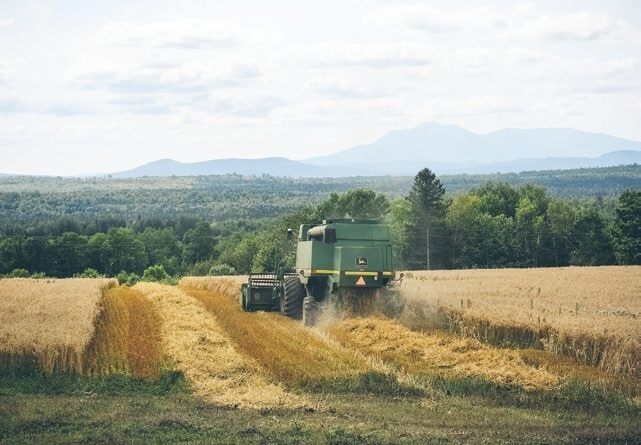
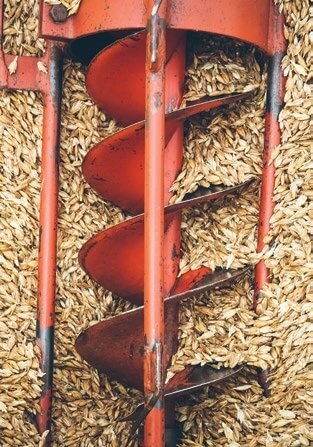
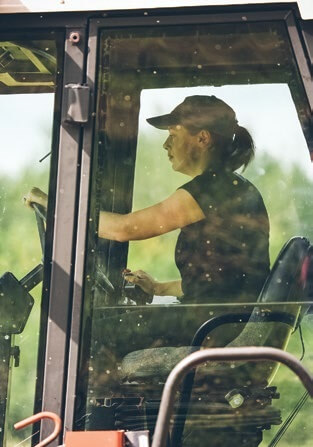

From Left to Right. Katahdin rises above fields of oats at Benedicta Grain Co. In 1987, as the town's population dipped to around 200 residents, Benedicta surrendered its plantation status and became an unorganized township.
Spelt in the auger. Spelt is an ancient wheat that is naturally lower in gluten.
Sara Williams Flewelling behind the wheel of a swather, cutting buckwheat into windrows so the grain can dry down in the field prior to being picked up for processing.
Sara, Marcus, and baby Annabelle in a field of Japanese buckwheat. Aurora is working with Takahiro Sato, chef/owner of Yosaku in Portland, to develop a soba noodle made with Maine buckwheat. The noodles will be available in his restaurant this summer.
But while Oxbow is experimenting with Maine malts and grains, the brewery still sources most of its malt from France and Germany. “We’re working towards using more and more Maine grains—and malts,” Tim Adams, co-founder and head brewer at Oxbow, told me—a statement that holds true for many other breweries as well.
About a quarter of the Bucks’ 1,000 acres is planted to barley; the next step will be hop vines, another critical element in beer-making. “The potato market is mature,” Jake Buck explained as we toured the malt house. Like Qualey and Dyer, the Buck brothers are diversifying from total reliance on potatoes. “We count on working with local farmers to spread the risks around,” Jake said. But they could do a lot more, he admitted. Right now, despite producing 240 tons of malt annually, they can’t keep up with in-state demand. And with just two maltsters in Maine (the Bucks’ place in Mapleton and Blue Ox Malthouse in Lisbon Falls), there’s room to grow.
Coincidentally, on the day I watched Matt Williams harvest oats, I caught up with Amaral, there at Aurora to take pictures for his new cookbook celebrating 25 years of Borealis. “When you’re making bread, you’re basically working with just four ingredients,” Amaral told me, “flour, water, yeast and salt. So it’s important to understand where each of these is coming from.”
As far as consistency, moisture in the grain is a key factor. Wheat, for instance, harvested at 18% moisture, must be dried down to 12 to 14% for safe storage. Otherwise, the grain starts to sprout, leading to the development of amylase, an enzyme that is undesirable, especially for baking. Grain high in amylase produces sticky bread; too low, on the other hand, and the bread will be unacceptably dry. “Variations in protein levels are just the nature of small-scale milling,” says Jim Amaral, who established Borealis Breads (then known as Bodacious) back in 1993. Larger-scale millers can blend various flours to a steady consistency to satisfy bakers’ needs, but the scale of grain growing in Maine, he said, has not yet arrived at that point.
Black Crow Bakery in Litchfield, turning out some of the most stunning bread in Maine over the last 25 years, uses some Maine grains but consistency crops up in any conversation with baker Mark Mickalide. Mickalide is unusual because he himself grinds the flours he uses. The biggest problem is what he calls bitterness in Maine-grown grains: “It doesn’t ripen to a real strong sweetness,” he said, adding that to get the flavor he wants, he blends, in equal quantities, Maine-grown grains with sweeter wheat from the High Plains and ordinary unbleached white flour.
Blending, then, is an issue of capacity. Yes, Maine could grow a lot more grain to supply the needs of both brewers and bakers—and it might well lead to greater possibilities for millers to blend flours. But reaching that capacity is not a quick process, especially not for organic grains, which are what bakers require.
Anyone involved in this revival of Maine grain growing agrees the movement began with Aurora’s modest Matt Williams, in symbiotic relationship with Borealis’s Jim Amaral. Amaral first got Williams involved in grains on a commercial scale. In the late 1990s with Borealis Bread a success, Amaral decided to enhance his line with a Maine-grown product.
“I kept asking, why aren’t we growing wheat in Maine?” Amaral recalled. Williams, who was then the Aroostook County Extension Service specialist in small grains, had been experimenting with grains in rotation on his Linneus farm. As Amaral pushed, Williams planted, first, a crop of hard red winter wheat harvested in 1998. With no milling capacity in Maine, the grain was trucked across the border to New Brunswick. That continued until the border crossing became difficult after September 2001, at which point Williams added a grist mill to his grain operation.
Amaral now uses Aurora wheat for all his sourdough starters, but he is particularly proud of “Aroostook,” a grainy loaf made 100% from Maine grains, mostly wheat, and mostly from Aurora.
Nor can you talk about grain in Maine without mentioning Amber Lambke and her vision of a “re- generative economy” for Central Maine. In 2012, she co-established the Maine Grains mill in Skowhegan in the old Somerset County jail, where Qualey Farms in Benedicta is among some 24 growers sending their grains in for processing. Maine has just two commercial stone grist mills, in Skowhegan and the one at Aurora. For a decade, Lambke, with a number of like-minded confederates, organized the annual summer Kneading Conference in Skowhegan. What the Common Ground Country Fair is for Maine’s organic farmers, the Kneading Conference has become for Maine’s grain farmers, brewers and bakers.
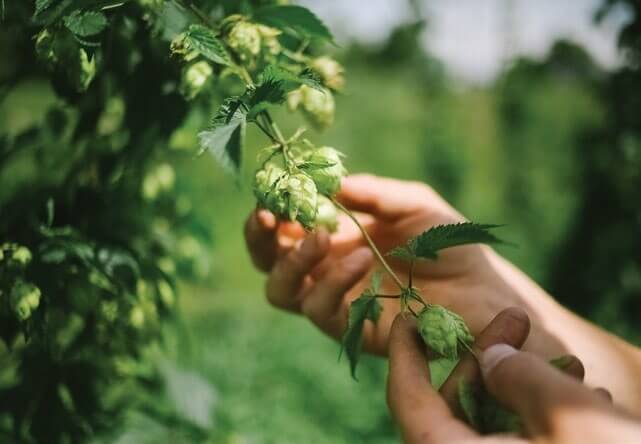
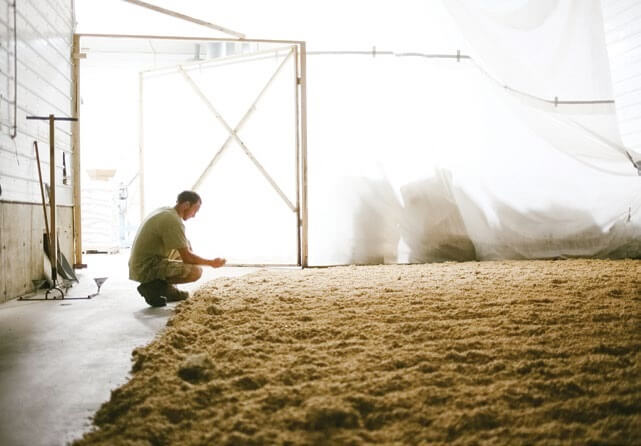
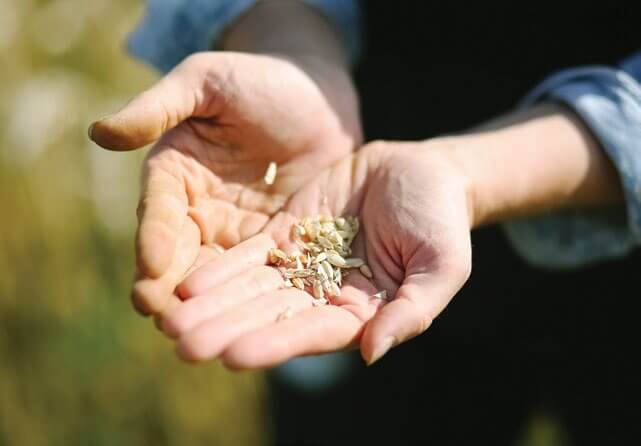
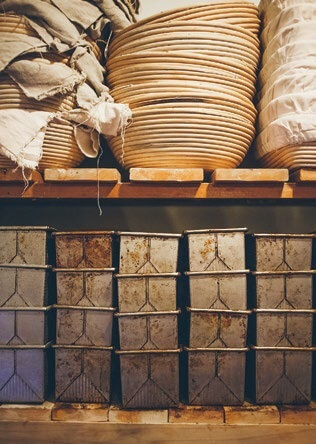
From Left to Right.Inspecting hops outside Maine Malt House in Mapleton. As the stalwart potato market continues to mature, young farmers like the Buck brothers are looking for ways to diversify, and Maine's booming craft beer industry offers new market opportunities.
Jake Buck checks the “chitted” barley on the malting floor at Maine Malt House. The Aroostook County malt house is one of just two malt houses in Maine helping to bring locally-grown grains to Maine brewers.
Sara Williams Flewelling holds a prized French heritage wheat, ‘Rouge De Bordeaux,’ known for its excellent baking quality and superior flavor. Over the past few years Aurora has been restoring the grain seed to marketable quantities and expects to have it available to customers this fall.
Maine bakers like Jim Amaral of Borealis have paved the way for more local grain production. While working with local flour can be less predictable than the standard King Arthur, bakers and eaters are enthusiastic about using Maine grains in breads and baked goods.
The Kneading Conference spurred the Maine Grain Alliance, now headed by Tristan Noyes, another young Aroostook native who, with his brother on the family farm in Woodland, is experimenting with several grains, including Sirvinta, a hard winter wheat from Estonia whose potential has a lot of Maine growers excited.
Noyes is equally enthusiastic about a new project for the Maine Grain Alliance, an 8-month feasibility study to look at creating drying, storing, and sorting facilities in four separate Aroostook County locations. This will take the onus off the shoulders of individual farms and farmers, and incidentally take a lot of the guesswork out of grain production.
Here in Aroostook (as in other parts of rural Maine) local and farm-to-table are not just fancy terms to sprinkle on chic restaurant menus. Local means community and an inter-connected economy. But there is still not enough local grain being grown and milled to serve Maine’s needs. I think of those 18,000 fallow acres up in the County where the climate is so good for grains—cool nights make sweeter wheat—and where taller varieties with better flavor and better baking quality can be grown. “Our biggest challenge is simply getting more land in production,” Matt Williams noted. “And it’s been the challenge from day one.”
Allagash’s Perkins cites a statistic from the University of Maine at Presque Isle—there are 18,000 acres of fallow or idle agricultural lands between Presque Isle and Caribou, all suited to grain cultivation. In fact, Aroostook farmers havegrown grains for a very long time, but almost always in rotation with potatoes (sometimes legumes, too). Such crops are either turned under as green manure or sold as low-value feed for chickens, pigs and cattle. What’s new in recent years is the focus on food-grade (as opposed to feed-grade) grains.
In the last decade or so, Maine has been fortunate to see an explosion of artisanal bread- and beer-crafting. We’ve come a long way since enriched sliced white breads (the Cushman’s and Nissen’s of my Camden childhood) and Haffenreffer and Narragansett fizzy brews. As of last winter, Maine had about 85 craft breweries, members of the Maine Brewers Association, and an estimated 51 craft bakeries, according to the Maine Grain Alliance, producing densely-grained, whole-meal loaves, often from wood-fired ovens, like the superbly nutty rye bread made with Aurora’s rye by Tim Semler at Tinder Hearth in Brooksville or the variety of breads and pastries at Standard Baking in Portland where, under Alison Pray’s direction in 2016, they used some 47,600 pounds of local wheat, oats, rye, cornmeal, and spelt, which represents 15% of their total grain use; and the number is climbing annually.
So why aren’t all of Maine’s brewers and bakers using Maine-grown grains? The answer is complex, but it boils down to three factors: 1) capacity, 2) consistency, and 3) price. On that last point, flour from the Skowhegan mill, says Camden baker Jeff Dec, is double the price of King Arthur flour—“and they’re really giving a good price to farmers.” Making grain profitable for farmers is obviously an important piece of the equation, but when bakers and brewers, who operate on similarly slim margins, can get good-quality flour, or malted barley, for half the price, it’s hard to argue with the choice. Still, bakers like Dec, Semler, Pray, and many others acknowledge their customers recognize the value in locally grown grain.
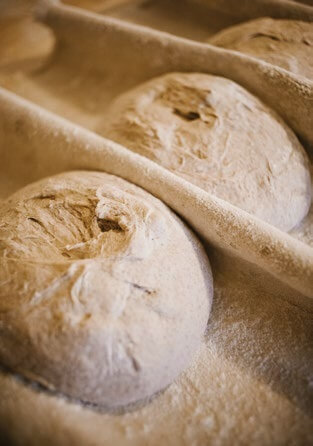
This article is from the 2017 issue of our Maine Farms journal. Make sure to look through our archives.
Sign up for our monthly email newsletter.